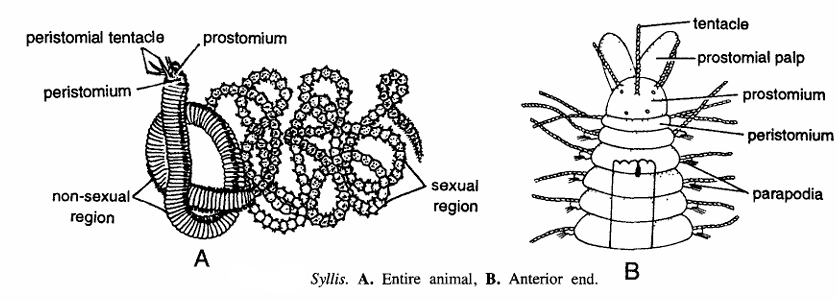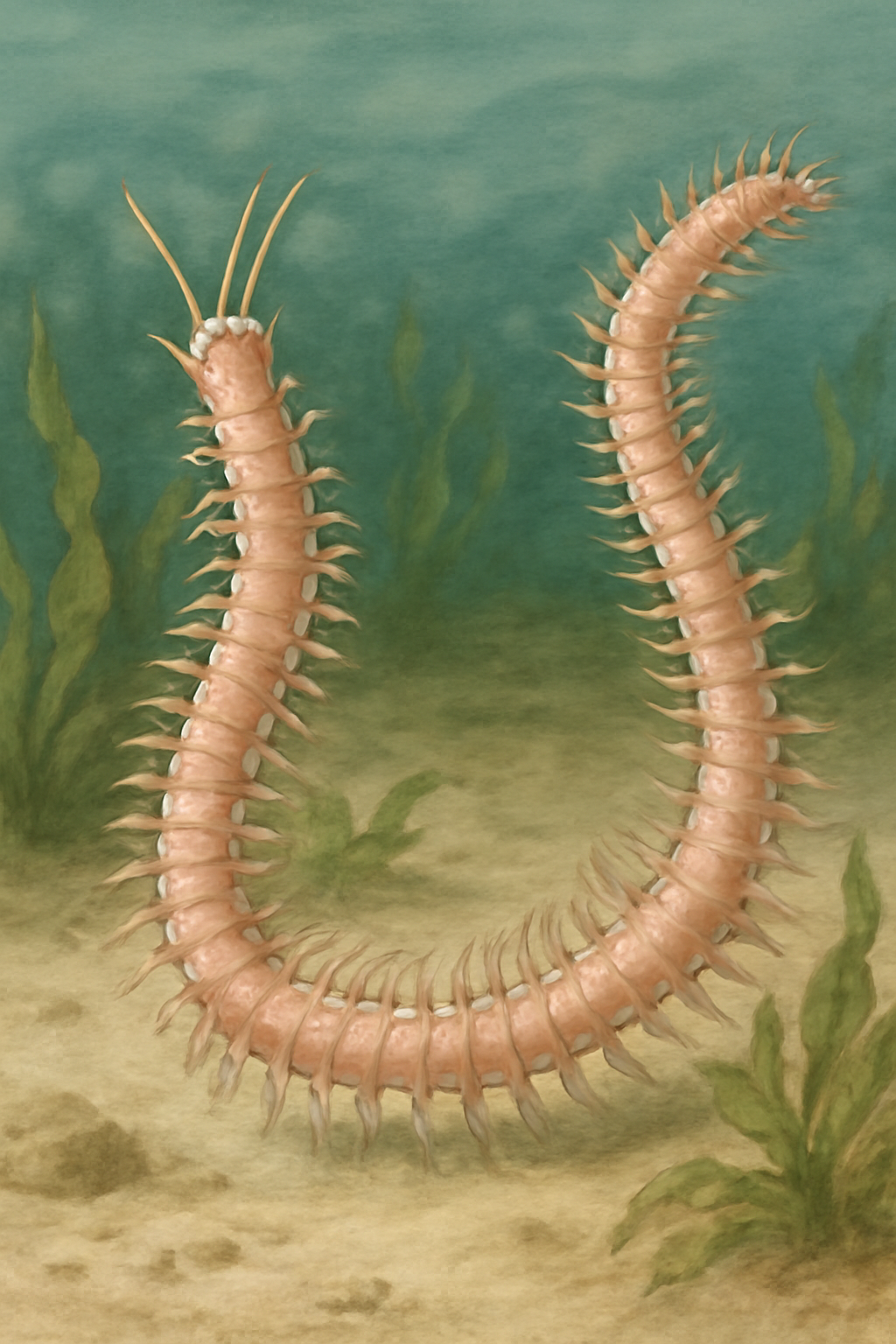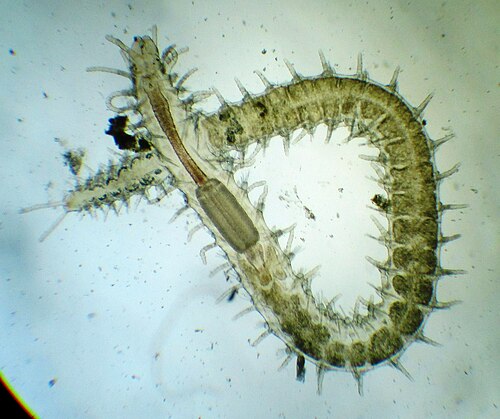Syllis: Biology, Classification, Habitat, Morphology, and Reproductive Features of the Polychaete Worm
Syllis is a genus of marine polychaete worms belonging to the family Syllidae. These worms are small to medium-sized segmented annelids, widely distributed in marine environments from intertidal zones to deeper waters. Syllis species are known for their diverse morphological adaptations, complex reproductive strategies, and ecological significance in benthic ecosystems. The genus exhibits varied lifestyles—some species are free-living while others display commensal or symbiotic relationships with other marine organisms.
Classification of Syllis
| Taxonomic Rank | Name | Characteristics |
|---|---|---|
| Kingdom | Animalia | Multicellular organisms with specialized tissues |
| Phylum | Annelida | Segmented worms with true coelom and metameric body plan |
| Class | Polychaeta | Marine worms with parapodia bearing chaetae |
| Order | Phyllodocida | Active, free-moving polychaetes with well-developed parapodia |
| Family | Syllidae | Small to medium-sized worms with diverse morphological and reproductive traits |
| Genus | Syllis | Polychaetes with complex pharynx and distinctive chaetae |

Habit and Habitat
Syllis species inhabit a variety of benthic marine environments, occupying sediments, algae, sponges, coral reefs, and other substrates. They are commonly found in intertidal to subtidal zones and can extend to deeper waters. Some species burrow within soft sediments, whereas others live on the surface or within biotic substrates, sometimes exhibiting epibiotic or symbiotic lifestyle traits. The genus is cosmopolitan, with species adapted to tropical, temperate, and polar regions.
Geographical Distribution
Syllis species are globally distributed throughout the world’s oceans. Notably abundant in tropical and temperate coastal waters, they have been recorded from the Mediterranean, North and South Atlantic, Pacific, Indian Ocean, and Arctic and Antarctic marine biomes. Some species show high local diversity, with complex species assemblages in coral reef habitats and rocky shores, indicating their ecological versatility.

General Characteristics
- Animal measures approximately 30 cm in length and divisible into head and body segments.
- Anterior end constitutes head which is fonned by prostomium and peristomium.
- Prostomium contains 2 pairs of prostomial eyes, 3 pairs of prostomial tentacles and 2 grooved and jointed palps.
- Each parapodium consists of a long jointed notopodiaI cirrus and a well developed neuropodium with nonnal setae and cirrus.
- The notopodium is absent. Pharynx contains a conical jaw connected to poison gland by its duct.
- During breeding season, body is distinguished into anterior asexual (atoke) and posterior sexual (epitoke) regions.
- In Syllis hyalina, the epitoke region separates and regenerates independent head (either male or female).
- In S. ramosa lateral buds are formed giving rise to much branched colony. Some of the lateral branches develop gonads and heads and later separate to become independent sexual adults.
- Body Form: Small to medium size, slender with up to 125 segments (chaetigers).
- Head: Prostomium with two pairs of lentigerous eyes, antennae, palps fused dorsally, and tentacular cirri.
- Parapodia: Present on most segments, with dorsal and ventral cirri of varying shapes and sizes.
- Chaetae: Dorsal simple chaetae or falcigers, often bidentate or unidentate with serrations; ventral chaetae present on posterior segments.
- Pharynx: Complex muscular structure extending several segments, with a dorsal tooth and various papillae aiding in feeding.
- Proventricle: Muscular organ aiding digestion with rows of muscle cells.
- Pygidium: Terminal segment bearing anal cirri that are digitiform or moniliform.
- Sensory Structures: Well-developed eyes and cirri for environmental sensing.
- Reproduction: Sexual reproduction with some species exhibiting vivipary and complex larval development.
Special Features
- Pharynx Morphology: The pharynx is highly specialized, with features supporting an omnivorous diet including soft tissues and detritus.
- Falcigerous Chaetae: The presence of compound chaetae with harpoon-shaped or hooked blades aids in locomotion and anchorage.
- Vivipary: Some Syllis species give birth to live young, rare among polychaetes.
- Regeneration: Ability to regenerate lost segments, facilitating survival in competitive environments.
- Species Diversity: Syllis has high species richness with frequent cryptic species complexes, complicating taxonomic identification.
- Symbiotic Interactions: Several species live associated with host sponges or other invertebrates, highlighting ecological relationships.

Identification
Identification of Syllis spp. requires detailed examination of morphological traits:
- Number and type of dorsal and ventral cirri.
- Structure and dentition of falcigerous chaetae.
- Shape and size of prostomial antennae and palps.
- Morphological details of pharynx and proventricle.
- Arrangement and form of anal cirri.
- Molecular markers increasingly used alongside morphology for species delineation.
Life Cycle and Reproduction
Syllis species exhibit diverse reproductive strategies. Most reproduce sexually, with external fertilization and free-swimming trochophore larvae settling to benthic juvenile stages. Some species show hermaphroditism or vivipary (live young development) which enhances reproductive success in variable environments. Epitoky or epitokous transformation is observed in some syllids, where parts of the body specialize for reproduction and pelagic swarming ensuring widespread gamete dispersal.
Ecological Role and Importance
- Benthic Food Web: Syllis worms contribute to nutrient cycling through detritivory and predation.
- Sediment Mixing: Their movement aerates sediments, promoting healthy benthic ecosystems.
- Prey and Predator: They serve as a food source for fish and larger invertebrates while actively preying on smaller organisms.
- Bioindicators: Presence and abundance can indicate environmental health and pollution levels in coastal habitats.
- Biodiversity Support: Their associations with other marine organisms add to habitat complexity and diversity.
References
- https://mapress.com/zt/article/view/zootaxa.3263.1.2
- https://pmc.ncbi.nlm.nih.gov/articles/PMC3192416/
- https://www.vliz.be/imisdocs/publications/289154.pdf
- https://www.cambridge.org/core/journals/journal-of-the-marine-biological-association-of-the-united-kingdom/article/two-new-species-of-syllis-polychaeta-syllidae-from-south-africa-one-of-them-viviparous-with-remarks-on-larval-development-and-vivipary/6F823F5B3877AE594624B14E182C1F42
- https://www.nature.com/articles/s41598-024-66465-4
- http://hbmahesh.weebly.com/uploads/3/4/2/2/3422804/4._life_cycle-morphology_of_non_mul-o_e_word_13-14.pdf
- https://www.sciencedirect.com/science/article/abs/pii/S2352485523004334
- https://www.slideshare.net/slideshow/life-cycle-of-silkworm-161600200/161600200
- https://journalarrb.com/index.php/ARRB/article/view/279
- https://www.shivajicollege.ac.in/sPanel/uploads/econtent/d7087d76d2106f258390ba1ec46c7e1c.pdf
- https://hts.assam.gov.in/frontimpotentdata/life-cycle-of-mulberry-silkworm
- https://www.slideshare.net/slideshow/life-cycle-of-silkworm/64966195
- https://bioone.org/journals/zoological-science/volume-36/issue-5/zs190058/Life-Cycle-of-the-Japanese-Green-Syllid-Megasyllis-nipponica-Annelida/10.2108/zs190058.full
- https://onlinelibrary.wiley.com/doi/10.1111/jzs.12336
- https://pmc.ncbi.nlm.nih.gov/articles/PMC6622173/
